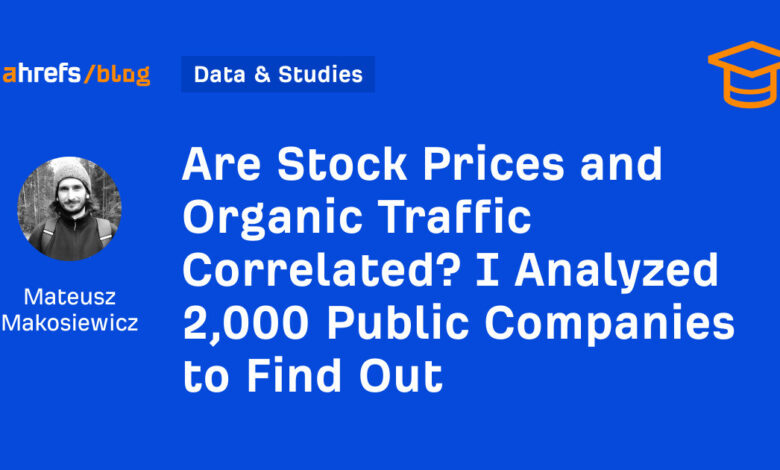Is There a Relationship Between Stock Prices and Organic Traffic? A Study of 2,000 Public Companies

SEO and the stock market are two seemingly unrelated worlds, but recent research has shown a strong positive correlation between organic traffic and stock prices on Nasdaq. This correlation opens up a new avenue for investors to potentially profit from understanding the impact of SEO on stock market performance.
The analysis conducted revealed that the combined stock prices of Nasdaq companies typically rose alongside the total organic traffic they received. There was a strong positive relationship between the market cap weighted standardized price and the total traffic of all Nasdaq stocks studied. This suggests that SEO may directly influence the stock value of companies that invest in it, particularly in industries such as consumer products, healthcare, finance, and real estate.
Interestingly, 32% of Nasdaq companies with at least 100k annual traffic showed a moderate to strong positive correlation between organic traffic and stock price. This indicates that there is a significant relationship between SEO efforts and stock market performance for a sizable portion of publicly traded companies.
While not all companies listed on Nasdaq exhibit a positive correlation between organic traffic and stock price, those that consistently invest in SEO and attract high levels of organic traffic tend to have a stronger connection between the two. These companies often benefit from increased brand awareness, customer acquisition, and revenue growth through their SEO efforts.
The analysis also highlighted that certain market sectors, such as technology, healthcare, finance, and consumer companies, may have a stronger link between SEO and stock market performance. These sectors tend to attract a larger portion of their organic traffic from search engines, making SEO a crucial factor in their overall market valuation.
It is important to note that correlation does not imply causation, and past performance is not indicative of future results. This information is for informational purposes only and does not constitute investment advice. However, the findings suggest that understanding the relationship between organic traffic and stock prices could potentially help investors make informed decisions and avoid losses in the market.
Overall, the research on the correlation between SEO and the stock market offers valuable insights into the impact of digital marketing strategies on financial performance. By leveraging SEO to increase organic traffic and enhance brand visibility, companies may be able to positively influence their stock value and attract potential investors in the competitive market landscape. When it comes to the impact of high-intent searches on revenue, it is clear that businesses across various industries can benefit from a strong SEO strategy. Whether it is finding a mortgage lender, shopping for consumer products, or searching for medical information, the ability to rank highly in search engine results can directly influence the bottom line.
However, not all industries will see a significant connection between SEO and stock price. For businesses in deeply B2B niches or highly regulated sectors where contracts are negotiated offline or through long lead cycles, organic traffic may be less predictive of market movements. The same goes for companies in specialized sectors where brand recognition is already strong or offline connections play a major role.
One interesting phenomenon that seems to give public companies an edge in SEO is what is known as entity SEO. Publicly traded companies often have a natural head start in Google’s search results due to their extensive online footprint, which includes mentions in financial news, investor portals, press releases, and other authoritative sources. This visibility amplifies their domain authority, allowing Google to easily associate them with certain topics or services. This gives them an advantage over less-established brands when it comes to SEO.
For example, companies like Kelly, Robinhood, Flexshopper, and Nvidia rank highly for relevant keywords without using those exact phrases on their websites. Google’s understanding of entities goes beyond keyword matching and may involve site context, user behavior, and external references like anchor texts in links.
Another missed opportunity for companies is not leveraging the link equity generated by PR efforts. Media coverage, press releases, awards, and relationships with journalists can lead to backlinks from trusted websites, improving search rankings and increasing online visibility. Offering quotes for journalists is a known link-building tactic that can be even more effective for well-known brands.
In the case of publicly traded companies, unique SEO tactics are not necessarily required. Many of the same strategies used by smaller businesses to drive traffic can be effective for larger companies as well. Examples include blogging, which can drive significant traffic and earn authoritative backlinks, and crafting landing pages for specific search queries.
In conclusion, the impact of high-intent searches on revenue is evident across industries, and a strong SEO strategy can play a crucial role in driving business success. Public companies may have an edge in SEO due to their entity status, but leveraging PR efforts and employing proven SEO tactics can benefit companies of all sizes. Ultimately, understanding the connection between SEO and revenue is essential for maximizing online visibility and driving business growth. In the world of digital marketing, there are many strategies that companies use to drive traffic to their websites and increase their online visibility. One strategy that has been gaining popularity is the use of product-focused clusters to attract targeted traffic. This approach involves creating landing pages that are optimized for specific products or services, with the goal of capturing a high percentage of overall site traffic.
One company that has successfully implemented this strategy is Makemytrip, a popular travel booking platform. By creating search-optimized landing pages for different travel ideas, they are able to cover a wide range of queries and attract an estimated 2.5 million visits each month. Similarly, Airbnb uses topic clusters to cater to searchers looking for specific types of accommodations, such as cabins, treehouses, and glamping.
Another effective tactic that companies are using is the combination of product marketing with content marketing. By creating product landing pages with an informational twist, companies like Nasdaq are able to rank for high-volume keywords and drive targeted traffic to their sites. This approach has helped companies like Micron rank twice for the same keyword, increasing their visibility and attracting more visitors.
In addition to product-focused clusters and informational landing pages, companies are also leveraging dictionaries, FAQs, and basic definitions to capture informational search intent and boost organic traffic. By providing valuable resources and information, companies like Crowdstrike and Qualcomm are able to attract a significant portion of their site’s traffic and increase their online visibility.
Another effective strategy that companies are using is the creation of free tools and resources. By offering tools to help users calculate, understand, or access certain information, companies can attract backlinks, credibility, and engaged visitors. For example, Adobe offers a range of free tools that generate an estimated 2.9 million visits each month, promoting their product suite and increasing their online visibility.
Furthermore, companies are also leveraging dynamic search results to target time-sensitive keywords and capitalize on seasonal trends. By indexing dynamic search results, companies like Adobe are able to rank for specific terms and attract a surge in searches, increasing their online visibility and driving targeted traffic to their sites.
Overall, companies are using a combination of strategies to increase their online visibility and attract targeted traffic to their websites. By implementing product-focused clusters, informational landing pages, free tools, and dynamic search results, companies are able to drive traffic, increase their visibility, and ultimately grow their business in the competitive online marketplace. In the fast-paced world of digital marketing, the importance of search engine optimization (SEO) cannot be overstated. Companies of all sizes are constantly striving to improve their online presence and reach more potential customers through search engines like Google. One key aspect of SEO that is often overlooked is its potential impact on the stock market.
A recent study found that there is a strong correlation between internet search trends and company stock prices and trading volume. In fact, the study showed that using search data to forecast stock market movements can result in a 40% outperformance of a traditional buy-and-hold strategy. This suggests that investors can use SEO data to make informed decisions and potentially profit in the stock market.
One example cited in the study is the use of organic traffic data to predict stock value fluctuations. By monitoring changes in organic traffic, investors may be able to identify patterns that could signal changes in stock prices. For instance, if a company’s organic traffic starts to decline, it could be a warning sign that their stock value may also drop in the near future.
In another study, researchers found that a search trend investment strategy outperformed average stock market returns over a seven-year period. This further highlights the potential of using SEO data to guide investment decisions and potentially achieve higher returns.
While the idea of using SEO data for stock market predictions may seem unconventional, the results speak for themselves. By leveraging the power of search data, investors can gain valuable insights into market trends and make informed decisions that could lead to increased profitability.
In conclusion, SEO data has the potential to be a valuable tool for investors looking to navigate the stock market. By analyzing search trends and organic traffic data, investors can gain a better understanding of market movements and potentially outperform traditional investment strategies. As the digital landscape continues to evolve, it is clear that SEO data will play an increasingly important role in shaping investment decisions.
FAQs:
- Can SEO data really be used to predict stock market movements?
- Yes, studies have shown a strong correlation between search trends and stock prices, indicating that SEO data can be a valuable tool for investors.
- How can investors leverage SEO data to make informed decisions?
- By monitoring changes in organic traffic and search trends, investors can gain insights into market trends and potentially predict stock value fluctuations.
- Have any studies shown success in using SEO data for stock market predictions?
- Yes, several studies have demonstrated that using SEO data can lead to outperformance of traditional investment strategies and higher returns.
- Is there a risk involved in using SEO data for investment decisions?
- Like any investment strategy, there are risks involved in using SEO data for stock market predictions. It is important for investors to conduct thorough research and analysis before making decisions.
- Can smaller companies benefit from using SEO data for investment purposes?
- While larger companies may have a built-in advantage, smaller companies can still benefit from leveraging SEO data to make informed investment decisions and potentially achieve higher returns. the topic: "The Impact of Social Media on Mental Health"
In recent years, social media has become an integral part of our daily lives. With the rise of platforms such as Facebook, Instagram, Twitter, and TikTok, people are spending more time than ever before scrolling through their feeds, liking posts, and sharing content. While social media has its benefits, such as connecting people from all over the world and providing a platform for self-expression, it also has a darker side that is often overlooked – its impact on mental health.
One of the most significant effects of social media on mental health is its role in perpetuating feelings of inadequacy and low self-esteem. When we constantly compare ourselves to the carefully curated lives of others on social media, it can lead to feelings of jealousy, insecurity, and even depression. Studies have shown that excessive use of social media is linked to higher levels of anxiety and lower self-esteem, especially among young people who are more susceptible to these negative effects.
Moreover, the pressure to present a perfect image of oneself on social media can also contribute to the development of body image issues and eating disorders. With the rise of filters and photo editing tools, people can easily alter their appearance to fit societal standards of beauty, leading to unrealistic expectations and dissatisfaction with one’s own body. This can have serious consequences on mental health, as individuals may develop unhealthy habits in an attempt to achieve an unattainable ideal.
Another concerning aspect of social media’s impact on mental health is its role in cyberbullying. With the anonymity that social media provides, people feel emboldened to say hurtful things to others without facing the consequences of their actions. Cyberbullying can have devastating effects on the mental health of the victim, leading to feelings of isolation, depression, and even suicidal thoughts. It is essential for social media platforms to take a stand against cyberbullying and implement measures to protect their users from this harmful behavior.
Despite these negative effects, social media can also be a source of support and connection for those struggling with mental health issues. Online communities and support groups provide a safe space for individuals to share their experiences, seek advice, and find comfort in knowing that they are not alone in their struggles. Social media can also be a platform for raising awareness about mental health and reducing the stigma surrounding mental illness, promoting understanding and empathy among users.
In conclusion, while social media has revolutionized the way we communicate and connect with others, it is essential to recognize its impact on mental health. By being mindful of our social media usage, setting boundaries, and seeking support when needed, we can mitigate the negative effects of social media on our mental well-being. It is crucial for social media platforms to take responsibility for the well-being of their users and implement measures to promote a healthy online environment. Only by addressing these issues can we harness the positive potential of social media while safeguarding our mental health.
- While larger companies may have a built-in advantage, smaller companies can still benefit from leveraging SEO data to make informed investment decisions and potentially achieve higher returns. the topic: "The Impact of Social Media on Mental Health"




